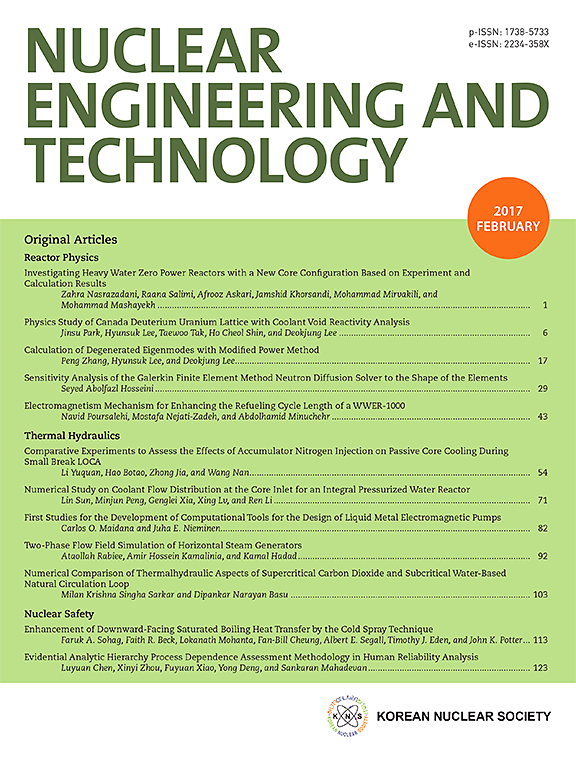从低温反应堆乏燃料中分离锶和钡的热力学研究
IF 2.6
3区 工程技术
Q1 NUCLEAR SCIENCE & TECHNOLOGY
引用次数: 0
摘要
从核乏燃料中分离碱土金属等高热负荷裂变产物,可以大大减轻乏燃料处置的负担。本研究调查了通过非水工艺从轻水反应堆乏燃料中分离锶和钡的可行性。研究开发了处理乏核燃料的工艺流程,通过高温加热去除挥发性核素,然后用氯化剂进行氯化处理。氯化产品随后在 LiCl-KCl 熔盐中用沉淀剂进行处理,以进一步分离。剩余液体经蒸馏回收锶和钡。对工艺流程进行了热力学平衡计算。在工艺流程条件下,氯化镁和 NHCl 都能将 SrO 和 BaO 分别完全转化为 SrCl 和 BaCl。沉淀剂 LiCO 的分离效果优于 LiPO。热力学计算表明,通过氯化镁氯化、LiCO 沉淀和蒸馏回收的锶和钡在质量、放射性和衰变热方面分别含有 0.18 %、1.06 % 和 0.32 % 的杂质。本文章由计算机程序翻译,如有差异,请以英文原文为准。
Thermodynamic study on the separation of strontium and barium from LWR spent fuel
The separation of high heat load fission products, such as alkaline earth metals, from nuclear spent fuel can significantly reduce the burden of spent fuel disposal. This study investigates the feasibility of separating strontium and barium from light water reactor spent fuel through non-aqueous processes. Process flows were developed for treating spent nuclear fuel by heating it at high temperatures to remove volatile nuclides, followed by chlorination with a chlorinating agent. The chlorinated products were then treated with a precipitating agent in LiCl-KCl molten salt for further separation. The remaining liquid was distilled to recover strontium and barium. Thermodynamic equilibrium calculations were conducted for the process flows. Under the conditions of the process flows, the chlorinating agents MgCl2 and NH4Cl both converted SrO and BaO entirely into SrCl2 and BaCl2, respectively. The precipitating agent Li2CO3 exhibited superior separation effectiveness compared to Li3PO4. Thermodynamic calculations indicate that strontium and barium recovered by MgCl2 chlorination, Li2CO3 precipitation, and distillation will contain 0.18 %, 1.06 %, and 0.32 % impurities in terms of mass, radioactivity, and decay heat, respectively.
求助全文
通过发布文献求助,成功后即可免费获取论文全文。
去求助
来源期刊

Nuclear Engineering and Technology
工程技术-核科学技术
CiteScore
4.80
自引率
7.40%
发文量
431
审稿时长
3.5 months
期刊介绍:
Nuclear Engineering and Technology (NET), an international journal of the Korean Nuclear Society (KNS), publishes peer-reviewed papers on original research, ideas and developments in all areas of the field of nuclear science and technology. NET bimonthly publishes original articles, reviews, and technical notes. The journal is listed in the Science Citation Index Expanded (SCIE) of Thomson Reuters.
NET covers all fields for peaceful utilization of nuclear energy and radiation as follows:
1) Reactor Physics
2) Thermal Hydraulics
3) Nuclear Safety
4) Nuclear I&C
5) Nuclear Physics, Fusion, and Laser Technology
6) Nuclear Fuel Cycle and Radioactive Waste Management
7) Nuclear Fuel and Reactor Materials
8) Radiation Application
9) Radiation Protection
10) Nuclear Structural Analysis and Plant Management & Maintenance
11) Nuclear Policy, Economics, and Human Resource Development
 求助内容:
求助内容: 应助结果提醒方式:
应助结果提醒方式:


